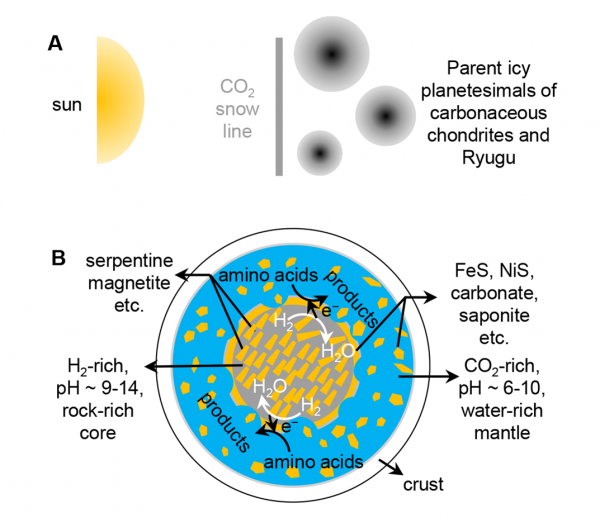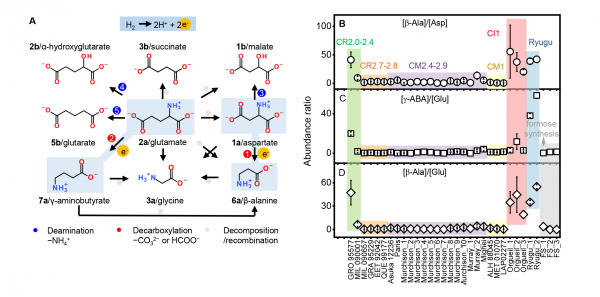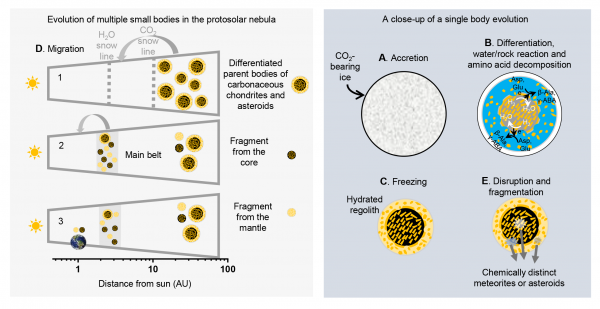Origin of life requires proteinogenic amino acids as the building blocks. Amino acids were ubiquitously found in carbonaceous chondrites (CCs) and the return samples from asteroid Ryugu. Thus, amino acid distribution can be used to constrain the chemical evolution history of their parent bodies. However, proteinogenic amino acids only enrich in limited CC groups, which remains a mystery. In a recent study, researchers have elucidated the aqueous chemical reactions that can break down the proteinogenic amino acids. This can deepen our understanding of the chemical evolution of the primitive Solar System bodies and its impact on life’s origin.

Carbonaceous chondrites (CCs) recorded the first several million-year evolution of our early Solar System. Many life’s building blocks have been discovered in CCs, including amino acids, nucleobase, sugar-related compounds, carboxylic acids, etc. CCs are organic-rich and “water”-rich (in the form of structural OH in minerals); thus, they have been considered as important suppliers of water and organics to the early Earth, two essential prerequisites for the origin of life.
However, not all the CCs’ organics are related to life. Many non-proteinogenic amino acids, despite their frequent identification in CCs, cannot be used by modern life nor contribute to the origin of life. All the proteinogenic amino acids are α-amino acids; however, some of the CCs’ amino acids have the amino group linking to the carbon not at α-site, such as γ-aminobutyric acid (hereafter denoted as γ-ABA) and β-alanine (β-Ala). Recent studies on different CC samples have revealed a remarkable heterogeneity in the amino acid distributions. Specifically, CCs with intensive aqueous alteration histories (petrologic type 1) contain less protein amino acids, with γ-ABA and β-Ala as two major species. This has also been observed in the heavily aqueously altered return samples of asteroid Ryugu brought by JAXA’s Hayabusa2 mission. Ryugu’s return samples are by far the most pristine extraterrestrial material from a carbonaceous asteroid. This suggests that the chemical process induced by aqueous alteration shaped the amino acid distribution. However, so far, no aqueous chemical processes have been demonstrated to explain these meteoritic observations.
Now for the first time, a team led by the Earth-Life Science Institute (ELSI) at Tokyo Institute of Technology in Japan, including Specially Appointed Associate Professors, Yamei Li, Hiroyuki Kurokawa (currently an Associate Professor at the University of Tokyo), and Professor Yasuhito Sekine, with collaborating researchers from multiple universities have now elucidated the reaction pathways that can breakdown the proteinogenic amino acids under electrochemical conditions. They proposed an electrochemical pathway that can couple the reductive decomposition of amino acids that occurred in the water-rich mantle with the hydrogen oxidation reaction that occurred in the rocky core (Figure. 1). By simulating such reactions, they found that two proteinogenic amino acids, glutamic acid (Glu) and aspartic acid (Asp), decompose to two non-proteinogenic amino acids (γ-ABA and β-Ala, respectively) using FeS and NiS as the catalysts (Figure. 2A). This sufficiently explains the meteoritic observation that heavily aqueously altered CCs and Ryugu’s return samples contain markedly enriched non-proteinogenic amino acids while the less altered CCs have more proteinogenic amino acids (Figure. 2B-D).
Moreover, the researchers proposed a new evolutionary model for justifying the chemical heterogeneity between different groups of CCs: CM, CI, and CR groups (Figure. 3). Provided the icy parent planetesimals were water/rock differentiated due to the very different water/rock ratios in the core and mantle, steep chemical and redox gradients would have been developed. Amino acids can be well preserved in the core but will be decomposed in the mantle. Along with the inward migration of these bodies, the collision and fragmentation of the body would generate asteroids with very different amino acid distributions. They proposed that such core/mantle differentiation can at least partly explain the observed amino acid heterogeneity among CM, CI, and CR groups and asteroid Ryugu. Additionally, the reaction pathways highly depend on the mineral catalysts and redox condition. This study provides rationales for using mineral-organic association to constrain the geochemical evolution history, which can be potentially applied to understand the chemical evolution of other water/rock interacted environments, including the recent return sample from asteroid Bennu by NASA’s OSIRIS-REx mission.


| Journal | Science Advances |
| Title of the paper | Aqueous breakdown of aspartate and glutamate to n-ω-amino acids on the parent bodies of carbonaceous chondrites and asteroid Ryugu |
| Authors | Yamei Li1*, Hiroyuki Kurokawa1, 2, Yasuhito Sekine1,3,4,5, Yoko Kebukawa3,6, Yuko Nakano1, Norio Kitadai7, Naizhong Zhang3, Xiaofeng Zang3, Yuichiro Ueno1,3,7, Gen Fujimori6, Ryuhei Nakamura1,8, Kosuke Fujishima1,9, Junko Isa1,10 |
| Affiliations |
|
| DOI | 10.1126/sciadv.adh7845 |
| Online published date | 15 December 2023 |
